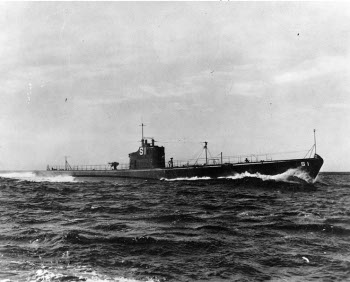![]() The Pacific War Online Encyclopedia
The Pacific War Online Encyclopedia
|
| Previous: Salmon | Table of Contents | Next: Salt Lake City |

Naval Historical Center #63417
| Tonnage | 1450 tons standard displacement 2200 tons submerged |
| Dimensions | 308' by 26' by 14'3" 93.9m by 7.92m by 4.34m |
| Maximum speed | 21 knots surfaced 9 knots submerged |
| Maximum dive |
250 feet 76 meters |
| Complement | 75 |
| Armament | 4 21" bow/4 21" stern torpedo
tubes (20 torpedoes) 1 3"/50 AA gun |
| Machinery |
2-shaft H.O.R. diesel (5500 shp)
or electric (3300 hp) |
| Bunkerage | 300 tons diesel oil |
| Range | 11,000 nautical miles (20,000 km) at 10 knots surfaced 96 nautical miles (178 km) at 2 knots submerged |
The Salmons were
completed in 1937-1939 and were a further development of the Shark class. They continued the
trend towards better habitability,
heavier torpedo
armament, and improved fire control.
Fleet exercises had shown that 17 knots was insufficient for a fleet
engagement, and improvements in underwater protection of battleships
created a requirement for greater firepower. The boats were the first class equipped with the torpedo data
computer (TDC), which was a simple electromechanical computer for
determining the correct bearing on which to launch torpedoes at a
target. Though primitive by today's standards, the TDC was a tremendous
innovation at the time, and it made a heavier stern tube armament more attractive by simplifying
fire control. However, calls for six forward torpedo tubes were
rejected on the grounds that the six-tube torpedo room would be too
congested; the extra tubes would increase the displacement to 1750
tons; and a salvo of six torpedoes would have to be spread out enough that one or two would miss anyway.
However, the boats were given two reloads for each forward tube and one
for each stern tube, plus two additional reloads carried externally.
The latter proved impractical and were removed before war broke out.
The boats boasted lightweight high-performance diesel engines designed by private firms, which were arranged as a composite plant. The two forward engines could drive either generators to recharge the batteries or electric motors to propel the boat, while the rear two engines were connected directly to the propeller shafts. This improved efficiency at little cost in recharge time, since the limiting factor was shown to be the ability of the batteries to absorb current rather than the output of the two engines driving the generators. The improved batteries allowed a boat to move at two knots submerged for 48 hours.
The Salmons were the first full class of
submarines to use welded construction and they could dive in less than
sixty seconds. However, the boats were not without their blemishes.
Several were powered by Hooven-Owens-Rentschler engines, or
H.O.R.s, pronounced "whores" by their frustrated engineering crews.
These broke down regularly, and were eventually replaced with General Motors engines.
They were still
fairly modern boats when war broke out, and all were deployed with Asiatic Fleet, where it was hoped they could pose a serious threat to any Japanese invasion force. However, a combination of inexperienced commanders and crews; poor tactical doctine; and miserable torpedoes meant that they accomplished almost nothing in the first Philippines campaign.
None were lost in combat, although Salmon was so badly damaged in a depth charge attack that she was written off as a constructive total loss.
| Severely damaged by depth charges 1944-10-30 in the Ryukyus and not repaired. |
||
| Skipjack | Cavite | |
References
The Pacific War Online Encyclopedia © 2007, 2009, 2011,2013 by Kent G. Budge. Index